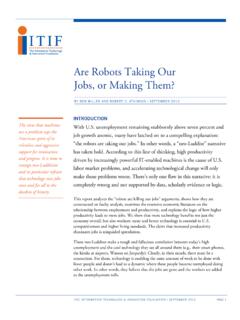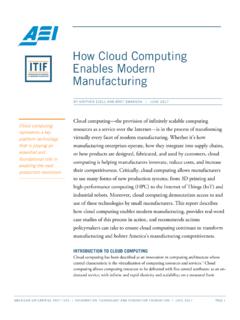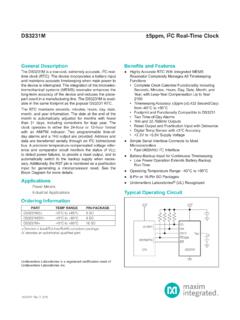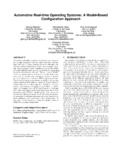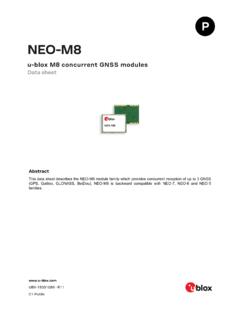Transcription of Why Manufacturing Digitalization Matters and How Countries ...
1 PAGE 1 INFORMATION TECHNOLOGY & INNOVATION FOUNDATION | APRIL 2018 Why Manufacturing Digitalization Matters and How Countries Are Supporting It BY STEPHEN EZELL | APRIL 2018 This report explains how Digitalization is transforming Manufacturing globally, detailing what exactly smart Manufacturing (or Industry ) is and examining the productivity impacts that digitalized Manufacturing promises to deliver. The report examines the small- to medium-sized enterprise (SME) Manufacturing support programs and policies of ten nations Argentina, Australia, Austria, Canada, China, Germany, Japan, Korea, the United Kingdom, and the United States and provides insights Countries can leverage to support the Digitalization of their manufacturers.
2 The report further examines how the development of common standards can facilitate technology adoption and proposes a typology that helps conceptualize different Manufacturing production systems and strategies, showing how these need to be supported by varying digital toolsets. The Digitalization of Modern Manufacturing Whether it s called Industry , as in Europe, the Industrial Internet of Things (IIoT), as in the United States, or just smart Manufacturing , the application of information and communication technology (ICT)
3 To every facet of Manufacturing is in the midst of reshaping modern This Digitalization of Manufacturing is changing how products are designed, fabricated, used, operated, and serviced post-sale, just as it s transforming the operations, processes, and energy footprint of factories and the management of Manufacturing supply This convergence of digital technologies with Manufacturing industries also promises to recast the landscape of global Manufacturing competition. The Digitalization of Manufacturing is changing how products are designed, fabricated, used, and serviced, just as it s transforming the operations, processes, and energy footprint of factories and supply chains.
4 PAGE 2 INFORMATION TECHNOLOGY & INNOVATION FOUNDATION | APRIL 2018 Smart Manufacturing is being driven by the advent and maturation of many technologies, including: high-performance computing (HPC)-powered computer aided design (CAD) and engineering (CAE) software; cloud computing; the Internet of Things; advanced sensor technologies; 3D printing; industrial robotics; data analytics; machine learning; and wireless connectivity that better enables machine-to-machine (M2M) communications. Amongst the most important of these are the marriage of sensors and software into the Internet of Things (IoT).
5 In the factory environment, IoT refers to the use of sensors in production equipment (such as robots, stampers, actuators, 3D printers, computer numerical control (CNC) machines, etc.), and the products they make (such as jet engines, gas turbines, radiological equipment, vehicles, etc.) to enable a real - time flow of information about the operational status and condition of the equipment or With IoT, devices are essentially enriched with embedded computing that allows them to interact and communicate with one In this way, many of the Things in IoT are really sensors embedded within devices, machines, and products that measure everything from output, consumption, wear, load, position, and capacity to salient operating conditions such as temperature, humidity.
6 And electrical flow. IoT will support Manufacturing execution systems, warehouse management systems, warehouse control systems, and transportation management systems deployed in shop floors and Integrating this information from multiple machines on the plant floor and then with information from other factories across the production chain, including those of suppliers can equip Manufacturing enterprises with real - time intelligence about their production processes and bestow them with the information needed to make better operational and production decisions.
7 These sensors play a key role in creating the information streams upon which smart Manufacturing techniques rely. Over the past decade, the cost of such sensors has declined over a hundredfold, while the number of sensors shipped globally increased from billion in 2012 to billion in Such sensors will account for a significant share of the 50 billion Things expected to be connected to the Internet by The application of IoT is projected to generate $ to $ trillion of value globally by 2025, in four primary forms: 1) operational efficiency; 2) predictive and preventative maintenance.
8 3) supply chain management; and 4) inventories and While manufacturers IoT implementations often address multiple facets of these Manufacturing processes, the following paragraphs provide specific examples of IoT being used to facilitate each of these four types of Manufacturing processes. Several case studies then follow examining how manufacturers have comprehensively leveraged IoT into their Manufacturing systems and go-to-market business models. Of the four IoT application forms listed above, analysts anticipate the application of IoT to maximize factory floor efficiency will have the largest impact, increasing productivity by as much as 25 There are many compelling examples.
9 For instance, consider General Electric s $170 million Manufacturing plant in Schenectady, New York, which makes massive batteries for equipment such as cellphone towers and power plants. More than PAGE 3 INFORMATION TECHNOLOGY & INNOVATION FOUNDATION | APRIL 2018 10,000 IoT-enabled sensors spread across 180,000 square feet of Manufacturing space collect temperature, humidity, air pressure, and machine operating data in real This allows GE to monitor production as it occurs and permits process adjustments to be executed on the fly, enhancing production efficiencies and conserving costs.
10 Additionally, battery performance can be traced back to specific batches of raw material at each step of the Manufacturing process. GE can thus trace a product s entire genealogy, from containers of dirt, sand, and salt, to a bank of high-tech batteries supporting a nation s electric Likewise, General Motors leverages sensors to monitor humidity conditions while vehicles are being painted; if the environmental conditions are unfavorable, the vehicle or part can be moved elsewhere in the facility or the ventilation systems adjusted as Similarly, Harley Davidson tracks fan speeds in its motorcycle painting areas and can algorithmically adjust the fans based on environmental Closely related to maximizing a factory s operational efficiency is the application of IoT to facilitate predictive and preventative maintenance.
